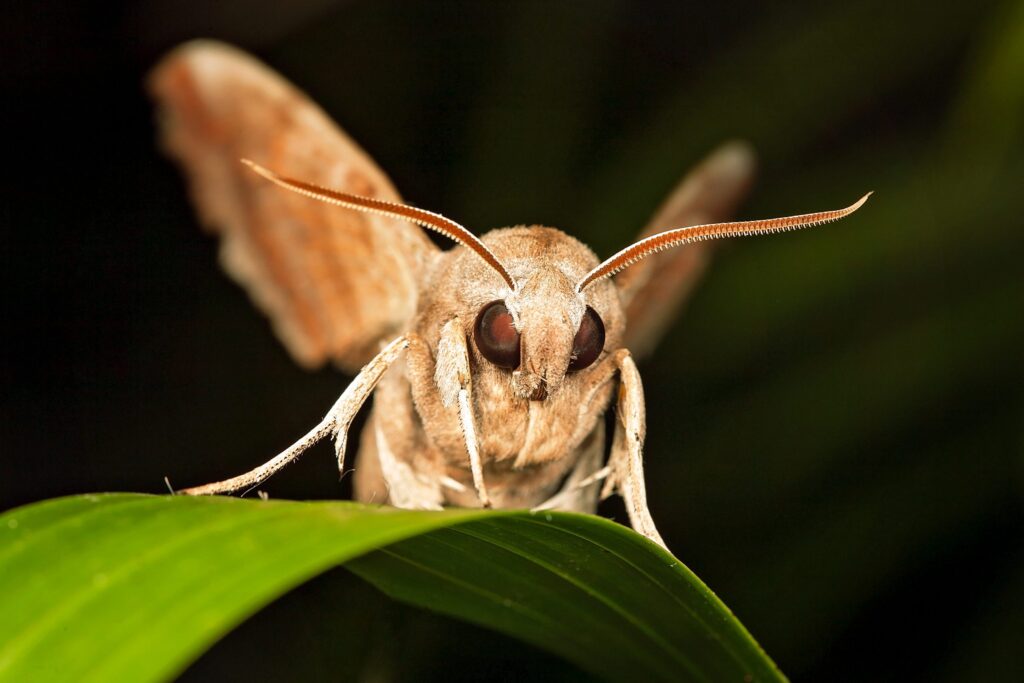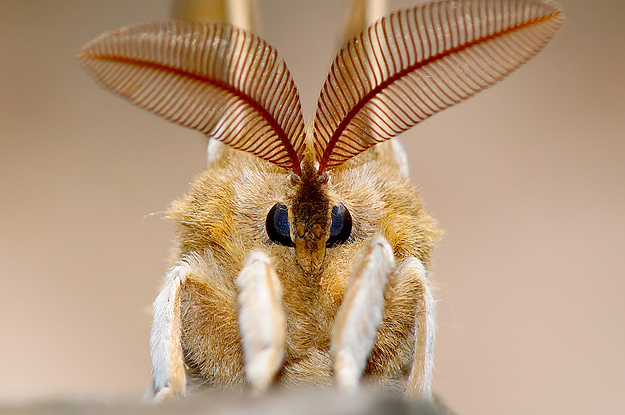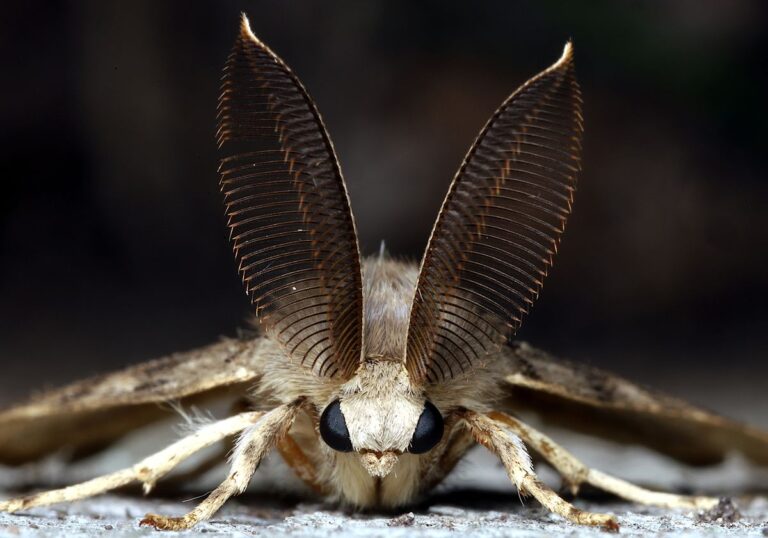Yes, moths, like other insects, have a circulatory system that carries a fluid similar to blood. However, this fluid is not called “blood” in insects; it is referred to as “hemolymph.” Hemolymph serves a similar function to blood in vertebrates but differs in composition.
Insects, including moths, have an open circulatory system. This means that their hemolymph is not enclosed in vessels like our blood is in veins and arteries.
Instead, the hemolymph bathes the internal organs directly. It plays essential roles in transporting nutrients, hormones, and immune cells around the insect’s body and also helps with temperature regulation.
How does the circulatory system in insects work?
Insects, including moths, have an open circulatory system. This system is quite different from the closed circulatory system found in vertebrates like humans. In an open circulatory system:
Hemolymph: Instead of blood, insects have a fluid called hemolymph. Hemolymph is a clear, colorless fluid that fills the body cavity (called the hemocoel) of insects. Unlike blood, hemolymph does not contain red blood cells or hemoglobin.
Lack of Vessels: Unlike vertebrates, insects lack a network of blood vessels, such as arteries and veins.
Moreover, hemolymph directly bathes the internal organs, including the heart (a tubular structure called the dorsal vessel) and other tissues.
Hemocoel: The body cavity, or hemocoel, serves as a reservoir for hemolymph. The hemocoel is not only responsible for transporting hemolymph but also plays a role in various physiological functions, such as support and protection for internal organs.
Comparison with the Closed Circulatory System in Vertebrates

To understand the significance of an open circulatory system in insects, it’s helpful to compare it to the closed circulatory system in vertebrates:
Vessel Structure: In vertebrates, the circulatory system consists of a complex network of blood vessels, including arteries that carry oxygenated blood away from the heart, and veins that return deoxygenated blood to the heart. In contrast, insects lack these vessels, relying on the body cavity for circulation.
Blood Composition: Vertebrates have specialized blood cells (red and white blood cells) and hemoglobin, which is responsible for oxygen transport. Insects have hemolymph, which lacks these specialized cells and molecules.
Efficiency: Closed circulatory systems in vertebrates are highly efficient at delivering oxygen and nutrients to tissues because blood is pumped through specific channels.
Insects rely on a slower, less precise system, where hemolymph moves somewhat passively through the hemocoel.
Role of the Circulatory System in Transporting Nutrients and Other Substances
The circulatory system in insects, including moths, serves several critical functions:
Nutrient Transport: Hemolymph carries nutrients, such as sugars and amino acids, absorbed from the insect’s diet to various tissues and organs. This ensures that cells receive the necessary energy and building blocks for growth and maintenance.
Waste Removal: Hemolymph also helps transport metabolic waste products away from cells and tissues. These waste products are eventually eliminated from the insect’s body.
Hormone Distribution: Insects use their circulatory system to transport hormones and signaling molecules throughout the body. This allows for coordinated physiological responses and behaviors.
Immune Function: Hemolymph contains immune cells (hemocytes) that defend against pathogens and foreign invaders. These cells play a crucial role in the insect’s immune response.
Temperature Regulation: Hemolymph circulation contributes to temperature regulation in insects, helping them maintain their optimal body temperature for various activities.
What is the composition of hemolymph in insects?
Hemolymph is the circulatory fluid found in insects, and it serves a role analogous to that of blood in vertebrates. Here’s a closer look at its definition and composition:
Definition: Hemolymph, often referred to as “insect blood,” is a clear, colorless fluid that fills the body cavity of insects, known as the hemocoel. Unlike vertebrate blood, it doesn’t contain red blood cells or hemoglobin.
Composition: Hemolymph consists of the following components:
- Plasma: The liquid portion of hemolymph is called plasma. It contains water, ions, and various solutes like sugars, amino acids, lipids, hormones, and waste products.
- Hemocytes: Hemocytes are specialized immune cells found in hemolymph. They play a crucial role in defending insects against pathogens and foreign invaders.
- Nutrients: Hemolymph transports nutrients absorbed from the insect’s diet, such as sugars and amino acids, to various tissues and organs.
Functions of Hemolymph in Insects
Hemolymph serves several vital functions in the life of an insect:
- Nutrient Transport: Hemolymph carries essential nutrients absorbed from the insect’s diet, ensuring that cells throughout the body receive the necessary energy and building blocks for growth and maintenance.
- Waste Removal: Metabolic waste products generated by cells and tissues are transported by hemolymph away from these sites. Eventually, these waste products are eliminated from the insect’s body.
- Hormone Distribution: Hemolymph acts as a transport medium for hormones and signaling molecules. These molecules regulate various physiological processes and behaviors in insects.
- Immune Function: Hemocytes present in hemolymph play a vital role in the insect’s immune system. They engulf and destroy pathogens, helping to defend the insect against infections.
- Temperature Regulation: Hemolymph circulation contributes to temperature regulation in insects. It helps distribute heat generated by metabolic processes, helping insects maintain their optimal body temperature for various activities.
How Hemolymph Differs from Vertebrate Blood
Hemolymph in insects is distinct from vertebrate blood in several ways:
Cellular Components: Vertebrate blood contains specialized cells, including red blood cells (erythrocytes) and white blood cells (leukocytes). In contrast, hemolymph lacks these specialized cell types, although it does contain hemocytes, which have immune functions.
Hemoglobin: Vertebrate blood contains hemoglobin, a protein that binds and carries oxygen. Hemolymph lacks hemoglobin, so oxygen is transported differently in insects, primarily through a system of tracheae (tiny air tubes) that deliver oxygen directly to cells.
Color and Transparency: Vertebrate blood is typically red due to the presence of hemoglobin. Hemolymph, on the other hand, is clear and colorless, making it visually distinct from vertebrate blood.
Vessel Structure: Vertebrate blood circulates through a closed system of arteries and veins. In contrast, hemolymph circulates through an open system within the body cavity, bathing internal organs directly.
How important is hemolymph in the life of moths?

Moths, like all insects, have a circulatory system based on hemolymph. This can be confirmed through various observations and studies, such as dissection and microscopic examination of moths. Here’s a deeper look:
Dissection: When moths are dissected for scientific purposes, researchers can observe the presence of hemolymph filling the body cavity (hemocoel). Hemolymph appears as a clear, colorless fluid that surrounds the internal organs and tissues.
Microscopic Examination: Under a microscope, hemolymph can be examined to identify its components, including plasma and hemocytes.
Furthermore, this examination helps confirm the presence of hemolymph in moths, which is consistent with the circulatory system of insects.
Specific Adaptations or Features Related to Hemolymph in Moths, If Any:
While the basic structure and composition of hemolymph are consistent across insect species, there may be some specific adaptations or features related to hemolymph in moths:
Flight Energy: Moths, especially nocturnal species, require bursts of energy for flight during their nightly activities. Hemolymph plays a vital role in transporting energy-rich compounds, such as sugars, which moths rely on to fuel their flight muscles.
Furthermore, this might lead to adaptations in the composition or transport of energy substrates in moth hemolymph.
Temperature Regulation: Some moths are adapted to withstand varying environmental temperatures. Hemolymph circulation can help regulate their body temperature, especially during cooler nights.
In addition, moths might have specialized mechanisms to control the flow and distribution of hemolymph to maintain thermal balance.
Immune Response: Hemolymph in moths, as in other insects, would contain hemocytes that contribute to the insect’s immune response.
Moths may have specific adaptations in their immune system to defend against pathogens encountered in their particular environments.
The Importance of Hemolymph in the Life of a Moth:
Hemolymph is crucial to the life of a moth for several reasons:
Nutrient Transport: Hemolymph carries essential nutrients, including sugars and amino acids, to various tissues, providing the energy required for daily activities and reproduction.
Waste Removal: Hemolymph helps remove waste products generated during metabolic processes, ensuring that the moth’s body functions efficiently and remains free of toxic byproducts.
Flight: Hemolymph plays a pivotal role in supplying energy substrates to the flight muscles, allowing moths to fly, find food, and evade predators.
Immune Defense: Hemocytes in hemolymph serve as a frontline defense against pathogens, protecting moths from infections and diseases.
Reproduction: Hemolymph is involved in the regulation of hormonal signals necessary for reproductive processes, including mating and egg-laying.
FAQ’s
What Colour is a moths blood?
Moth blood, like that of most insects, is typically clear or colorless.
Is moth blood red?
No, moth blood is not red; it is clear or colorless.
Do insects have blood?
Yes, insects have a circulatory fluid called “hemolymph,” which serves functions similar to blood in vertebrates.
What is the red stuff from moths?
The red pigment in some moths is often due to pigments in their scales or body tissues, not their blood.
Do moths feel pain?
Insects, including moths, do not possess the neurological structures necessary for experiencing pain as mammals do.
Do ants have blood?
Yes, ants also have hemolymph, which serves as their circulatory fluid.
Do insects feel pain?
Insects lack the complex nervous systems found in mammals, and there’s limited evidence to suggest they can feel pain in the way humans do.
Why is moth blood like dust?
Moth blood, or hemolymph, can appear dusty when it dries because it contains various proteins and substances that may leave residue as it solidifies.
Final Thought
In conclusion, our exploration of moths and their circulatory system has shed light on the fascinating world of insect physiology. Moths, like all insects, rely on hemolymph, their equivalent of blood, to carry out essential functions such as nutrient transport, waste removal, immune defense, and temperature regulation.
While the circulatory system in moths shares similarities with other insects, there may be specific adaptations related to their unique behaviors and environmental challenges.
Understanding the importance of hemolymph in the life of a moth not only deepens our appreciation for these creatures but also highlights the intricacies of nature’s designs.
Furthermore, the knowledge gained from this exploration can contribute to a broader understanding of insect physiology and ecology, ultimately enriching our comprehension of the natural world.

